#Nixon's Apollo Theatre
Text
FIXING SISTER
1916
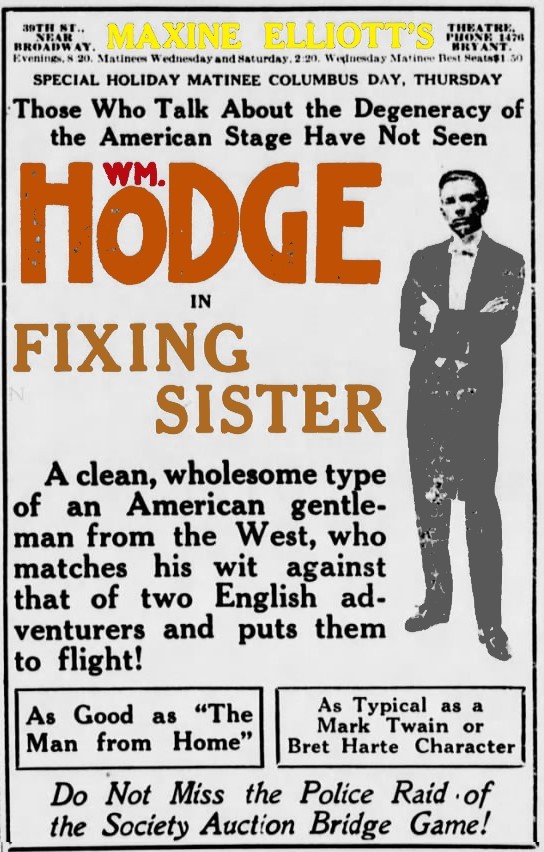
Fixing Sister is a four-act play by Lawrence Whitman (aka William Hodge). It was originally produced by Lee Shubert starring Mr. Hodge.
‘Fixing Sister’ tells how a devoted brother outwits a headstrong sister who has been carried away by the temptations of luxury, title-hunting, and bridge whist gambling, in the midst of the gay society life of the metropolitan rich. As a result of her foreign travels, she has almost annexed a foreign nobleman of untested lineage. Her brother. John Otis, a representative American of a shrewd and humorous sort, learning of his sister’s peril, hastens to New York from Kansas City. It Is his native common sense and shrewdness which effect a not sudden, but finally very effective, cure, including staging a police raid at her bridge party. He also rescues his own sweetheart, a tantalizingly Independent sort of American girl, from the wiles and the guiles of New York society and foreign nobility.
All four acts take place in New York City.
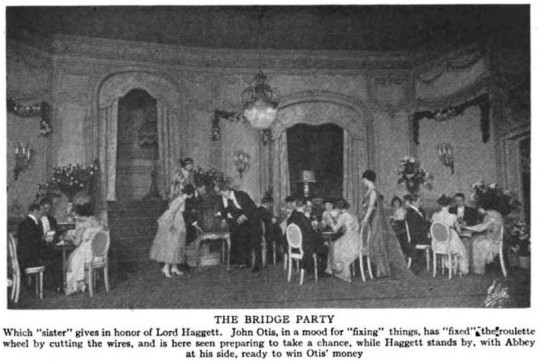
Bridge whist is a card game popular in the early 20th century. It was derived from whist with the additional rules that the players would take turns as dummy and that the trump suit would be deliberately chosen (including the option not to have one) on each deal rather than random.
"Next Thursday night will be ‘police night' at Maxine Elliott's Theater, when the members of the police department gambling squad will attend in a body to see the performance of William Hodge in ‘Fixing Sister,' in order to enjoy the spectacular police raid of a gambling party, which furnishes an exciting climax to the third act.” ~ EVENING STAR

The somewhat odd title was one of a dozen considered by Hodge. It was originally announced as The Social Climbers, but that seemed too similar to Clyde Fitch’s 1901 play The Climbers.
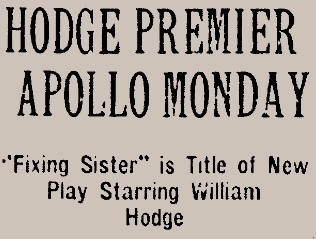
Fixing Sister opened in Atlantic City at Nixon’s Apollo Theatre on January 16, 1916. From there, it traveled to Wilmington DE, Altoona PA, Pittsburgh PA, and Boston MA.
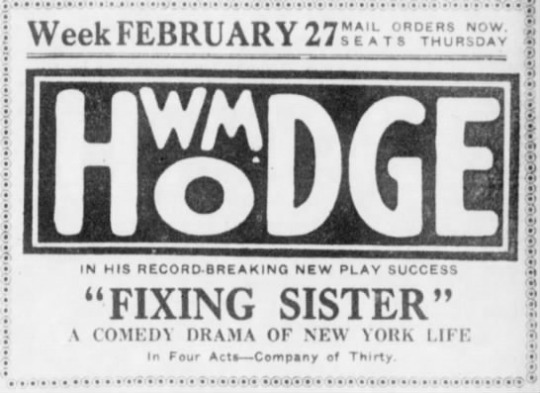
After Beantown (Boston), Hodge and company went to the Motor City (Detroit) before returning to Boston’s Majestic, where business was brisk.
“As an indication of the volume of business being done, it was necessary, on Ash Wednesday, to place the orchestra on the stage and sell seats in the pit usually occupied by the musicians.”
In mid-March 1916, Hodge made a formal announcement confirming the rumors that he was indeed playwright Lawrence Whitman. At the end of March, Hodge took on a second play in his downtime: Hobson’s Choice at the Wilbur. He requested that Mr. Shubert cancel one of his Fixing Sister matinees so that he might perform in Hobson’s, but Shubert declined. Instead, he arranged a special benefit of Hobson’s at an alternate time.

Although the above item appears to be an article, it is actually a paid advertisement! Do not send Miss Maxwell-Conover stray cats!
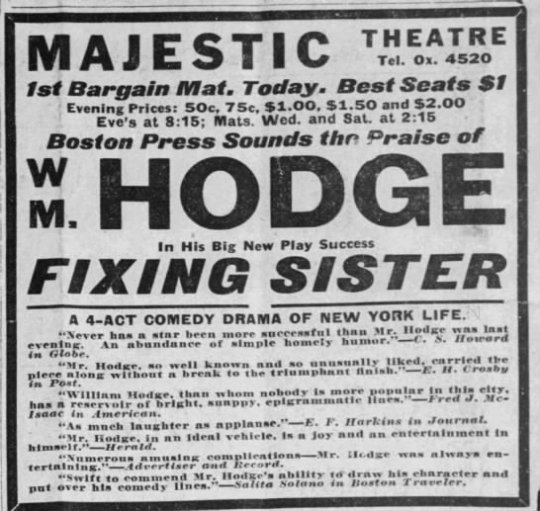
The Boston engagement finally came to an end on April 22, 1916. Although Broadway seemed the next logical step, the play moved to Maine through the end of the month. Hodge then retired to his summer home on Long Island to be with his wife and three small children, looking forward to bringing the play to Broadway in the new season.

Getting the play back on its feet, Hodge chose Pittsburgh, returning to the Alvin, where the play initially enjoyed a brief stay.

Fixing Sister opened on Broadway at Maxine Elliott’s Theatre (109 West 39th Street) on October 4, 1916.
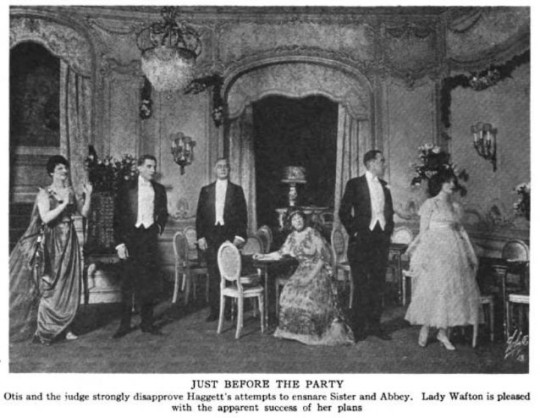
“Early in the play the audience is let into the secret. The onlooker is taken into the confidence of the leading character and the game is won. The audience plays the rest of the piece. The interest and enthusiasm is so alive that it comes in waves to me across the footlights. Such a play is bound to be a delight to both the folk who play it and those who are entertained by it.” ~ WILLIAM HODGE
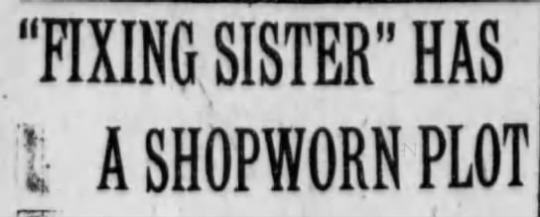
“Mr. Whitman’s play dramatizes the yellow journal idea of society life in Manhattan.” ~ BROOKLYN DAILY EAGLE
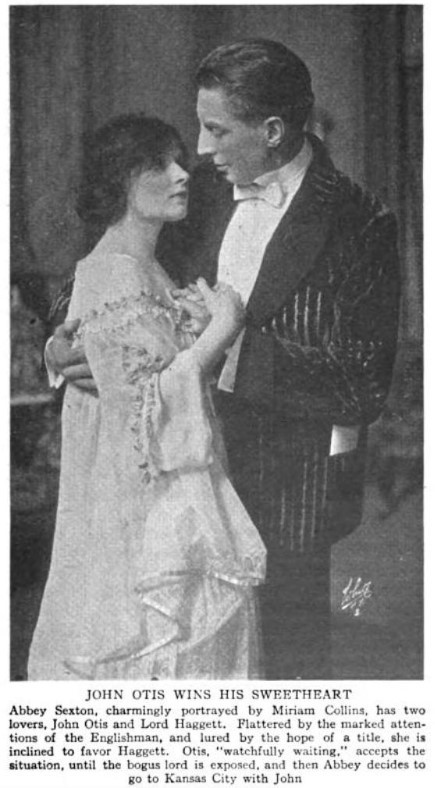
“When will Missouri stop ‘showing’ us New York?” ~ CHARLES DARNTON
Hodge’s character, John Otis, is from Kansas City, Missouri (aka the ‘Show Me’ State)
“Interest is sustained as long as [Hodge] is on the stage, making droll remarks about everything in general in his inimitable manner, but it lags perceptibly when the other characters are depended upon to keep things going.” ~ BROOKLYN LIFE

In early November, the production cleverly addressed rumors that Hodge would close the New York production and tour. A week later, the play was extended, selling advance tickets for as far ahead as New Year’s.
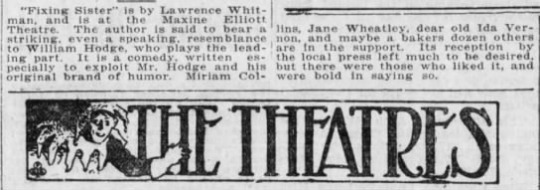
Despite this, Hodge packed his tents and moved the play to Chicago a week before Christmas. It ran on Broadway for 85 performances.
#Fixing Sister#1916#William Hodge#Lee Shubert#Nixon's Apollo Theatre#Atlantic City#Maxine Elliott's Theatre#Broadway#Broadway Play#Broadway Theatre#Lawrence Whitman
24 notes
·
View notes
Text
Band of brothers characters as Greek Gods/Goddess
Dick Winters - Achilles: the strongest warrior and hero in the Greek army during the Trojan War.
Lewis Nixon - Patroclus: Achilles Lover and Companion
Carwood Lipton - Persephone: the goddess queen of the underworld
Ronald Speirs - Hades: king of the dead.
Harry Welsh - Apollo: the god of music and healing.
George Luz - Hermès: the messenger god, a trickster, and a friend to thieves
Joe Toye - Hephaestus: the god of fire and the forge
Bill Guarnere - Dionysus: god of the grape harvest, winemaking and wine, of ritual madness, religious ecstasy and theatre.
Babe Heffron - Hera: The queen goddess of Olympus
Eugene Roe - Asclepius: God of medicine, health, healing, rejuvenation and physicians
Shifty Powers - Artemis: the goddess of the hunt
#band of brothers#bandofbrothers#dick winters#lewis nixon#babe heffron#baberoe#richard winters#carwood lipton#bill guarnere#david webster#shifty powers#eugene roe#greece#greek gods#greek poetry#greek blog#greek myth memes
50 notes
·
View notes
Text




A June 7th, 1926 program (playbill) from the one-week, Pre-Broadway engagement of the Eighth Annual Edition of the musical revue "GEORGE WHITE'S SCANDALS" at Nixon's Apollo Theatre in Atlantic City, New Jersey. (The 8th edition would open June 14th, 1926 at the Apollo Theatre in New York City and run for 432 performances.) ..... This series of revues, produced by White from 1919 through 1939, were given to elaborate show numbers much like the "Ziegfeld Follies", but were less ornate and cumbersome. Their comedy tended to be far more topical and, because White had been a dancer, the productions were fast paced and featured better choreography and music than similar revues. The scenery and curtains for this, the eighth edition of the "Scandals" were designed by ERTE and the musical score included GEORGE GERSHWIN's "Rhapsody in Blue" (second scanned image) ..... The All-Star Cast included ANN PENNINGTON, WILLIE and EUGENE HOWARD, TOM PATRICOLA, HARRY RICHMAN, BUSTER WEST, FRANCES WILLIAMS, the McCARTHY SISTERS, the FAIRBANKS TWINS, FOWLER & TAMARA, LLOYD GARRETT, ARTHUR GORDONI (eliminated out-of-town), ROSE PERFECT, JOHN WELLS, BERNARDO DE PACE, JANE SELS, JAMES CARTY, PEGGY GALLIMORE, JEAN KENIN, the SCOTT SISTERS, the HASTINGS SISTERS, FLO BROOKS, MURIEL LeCOUNT, LAVERTA McCORMACK, FRED LYON, MARGARET MANNERS, HARRY MORRISSEY, CATHERINE CHAPMAN, PATRICIA PURSLEY, PEGGY MOSELY, NORMA CLOOS, MAY SLATTERY and GEORGE WHITE'S BALLET ..... CREDITS: Book by WILLIAM K. WELLS and GEORGE WHITE; Music by RAY HENDERSON; Lyrics by B. G. DeSYLVA and LEW BROWN; "Rhapsody in Blue" composed by GEORGE GERSHWIN ("Girl Crazy", "Lady, Be Good!", "Oh, Kay!", "Funny Face", "Rosalie", "Of Thee I Sing", "Porgy and Bess", "George White's Scandals"); Costumes and Curtains designed by ERTE; Conceived, Produced and Directed by GEORGE WHITE .....
#GeorgeWhiteScandals #GeorgeGershwin #AnnPennington #FricPic
1 note
·
View note
Text
Pearl Bailey

Pearl Mae Bailey (March 29, 1918 – August 17, 1990) was an American actress and singer. After appearing in vaudeville she made her Broadway debut in St. Louis Woman in 1946. She won a Tony Award for the title role in the all-black production of Hello, Dolly! in 1968. In 1986, she won a Daytime Emmy award for her performance as a fairy godmother in the ABC Afterschool Special, Cindy Eller: A Modern Fairy Tale.
Her rendition of "Takes Two to Tango" hit the top ten in 1952. She received the Screen Actors Guild Life Achievement Award in 1976 and the Presidential Medal of Freedom on October 17, 1988.
Early life
Bailey was born in Newport News, Virginia, United States, to the Reverend Joseph James and Ella Mae Ricks Bailey. She was raised in the Bloodfields neighborhood of Newport News, Virginia. She graduated from Booker T. Washington High School in nearby Norfolk, Virginia, the first city in the region to offer higher education for black students. Blues singer Ruth Brown from Portsmouth, Virginia was one of her classmates.
She made her stage-singing debut when she was 15 years old. Her brother Bill Bailey was beginning his own career as a tap dancer, and suggested she enter an amateur contest at the Pearl Theatre in Philadelphia. Bailey won and was offered $35 a week to perform there for two weeks. However, the theatre closed during her engagement and she was not paid. She later won a similar competition at Harlem's famous Apollo Theater and decided to pursue a career in entertainment.
Career
Bailey began by singing and dancing in Philadelphia's black nightclubs in the 1930s, and soon started performing in other parts of the East Coast. In 1941, during World War II, Bailey toured the country with the USO, performing for American troops. After the tour, she settled in New York. Her solo successes as a nightclub performer were followed by acts with such entertainers as Cab Calloway and Duke Ellington. In 1946, Bailey made her Broadway debut in St. Louis Woman. For her performance, she won a Donaldson Award as the best Broadway newcomer. Bailey continued to tour and record albums in between her stage and screen performances. Early in the television medium, Bailey guest starred on CBS's Faye Emerson's Wonderful Town.
Her support of female impersonator Lynne Carter led him to credit Bailey with launching his career.
In 1967, Bailey and Cab Calloway headlined an all-black cast version of Hello, Dolly! The touring version was so successful, producer David Merrick took it to Broadway where it played to sold-out houses and revitalized the long running musical. Bailey was given a special Tony Award for her role and RCA Victor made a second original cast album. That is the only recording of the score to have an overture which was written especially for that recording.
A passionate fan of the New York Mets, Bailey sang the national anthem at Shea Stadium prior to game 5 of the 1969 World Series, and appears in the Series highlight film showing her support for the team. She also sang the national anthem prior to Game 1 of the 1981 World Series between the New York Yankees and Los Angeles Dodgers at Yankee Stadium.
Bailey hosted her own variety series on ABC, The Pearl Bailey Show (January – May 1971) which featured many notable guests, including Lucille Ball, Bing Crosby and Louis Armstrong (one of his last appearances before his death).
Following her 1971 television series, she provided voices for animations such as Tubby the Tuba (1976) and Disney's The Fox and the Hound (1981). She returned to Broadway in 1975, playing the lead in an all-black production of Hello, Dolly!. In October 1975, she was invited by Betty Ford to sing for the Egyptian President Anwar Sadat in a White House state dinner, as part of Middle-Eastern peace initiative.
She earned a degree in theology from Georgetown University in Washington, D.C., in 1985 at age 67. Here she was a student of Wilfrid Desan.
Later in her career, Bailey was a fixture as a spokesperson in a series of Duncan Hines commercials, singing "Bill Bailey (Won't You Come Home)". She also appeared in commercials for Jell-O, and Westinghouse.She also did some free -spirited commercials for Paramount Chicken.
In her later years Bailey wrote several books: The Raw Pearl (1968), Talking to Myself (1971), Pearl's Kitchen (1973), and Hurry Up America and Spit (1976). In 1975 she was appointed special ambassador to the United Nations by President Gerald Ford. Her last book, Between You and Me (1989), details her experiences with higher education. On January 19, 1985, she appeared on the nationally televised broadcast of the 50th Presidential Inaugural Gala, the night before the second inauguration of Ronald Reagan. In 1988 Bailey received the Presidential Medal of Freedom from President Reagan.
Personal life
On November 19, 1952, Bailey married the jazz drummer Louie Bellson in London.
They later adopted a son, Tony, in the mid-1950s. A daughter, Dee Dee J. Bellson, was born April 20, 1960. Tony Bellson died in 2004. Dee Dee Bellson died on July 4, 2009, at the age of 49, five months after her father, who died on Valentine's Day 2009.
Bailey, a Republican, was appointed by President Richard Nixon as America's "Ambassador of Love" in 1970. She attended several meetings of the United Nations and later appeared in a campaign ad for President Gerald Ford in the 1976 election.
She was awarded the Bronze Medallion in 1968, the highest award conferred upon civilians by New York City.
Bailey was a very good friend of actress Joan Crawford. In 1969, Crawford and Bailey joined fellow friend Gypsy Rose Lee in accepting a USO Award. In the same year, Bailey was recognized as USO "Woman of the Year". Upon the passing of Crawford in May 1977, Bailey spoke of Crawford as her sister before singing a hymn at her funeral. U.S. Ambassador and American socialite Perle Mesta was another close friend of Bailey. In the waning days of Mesta's life, Bailey visited her frequently and sang hymns for her.
Death
Pearl Bailey died at Thomas Jefferson University Hospital in Philadelphia on August 17, 1990. Following an autopsy, Dr. Emanuel Rubin, professor and chairman of the Department of Pathology at Jefferson Medical College, announced the cause of death as arteriosclerosis, with significant narrowing of the coronary artery. Bailey is buried at Rolling Green Memorial Park in West Chester, Pennsylvania.
Remembrances
The television show American Dad! features Pearl Bailey High School.
The 1969 song "We Got More Soul" by Dyke and the Blazers includes Bailey in its roster of icons.
A dress owned by Bailey is at the National Museum of African American History and Culture.
13 notes
·
View notes
Photo

1929 Nixon’s Apollo Theatre in Atlantic City, New Jersey.
68 notes
·
View notes
Photo
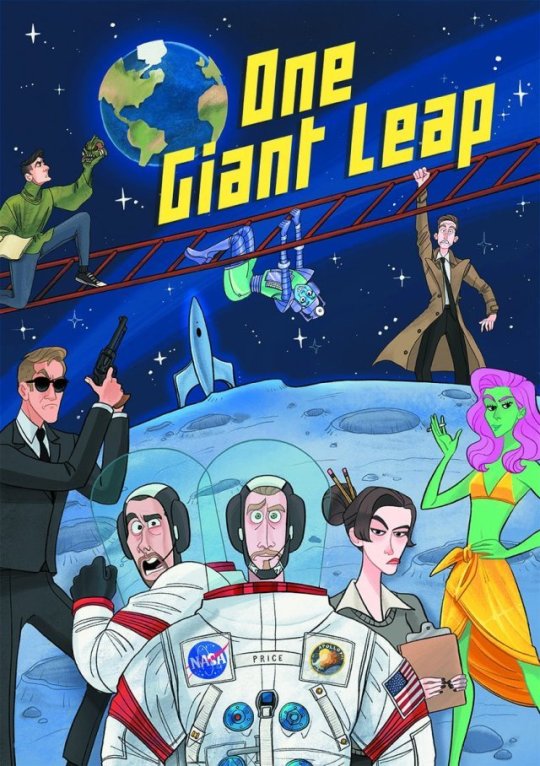
ONE GIANT LEAP Brockley Jack Theatre 2 – 27 July 2019 “That’s one small step for man…” Neil Armstrong INTERVIEW WITH WRITER & DIRECTOR OF ARROWS AND TRAPS THEATRE, ROSS MCGREGOR LPT: Hello Ross, We’re rather pleased to have another chat with you about your company, the award nominated Arrows & Traps but also wanted to grill you a little bit on your new writing, ONE GIANT LEAP. How long did it take you to write it? Hi there, how lovely to be asked. I have a somewhat unusual process in that I pitch the idea to the Jack, book the slot, design the artwork / poster, get the show on sale, start selling tickets and only then start writing the script. This is partly due to the quick turnaround of shows and my lack of time between, and also that we have to book these things quite far in advance as the Jack is a popular and sought-after space, but also because I have an issue with self-discipline, and so if I didn’t have a concrete deadline, I think I’d still be tinkering with Frankenstein, a show I wrote and produced in 2017. One Giant Leap is the first completely original piece that I’ve written without a source material, and it took me about two weeks to get onto paper. ONE GIANT LEAP is celebrating the fiftieth Anniversary of the Apollo 11 Moon Landing but it seems you have got your own spin on it. Could you tell us the story in nutshell? Yes absolutely. It’s a comic take on the greatest conspiracy in history. It centres on Edward Price, a producer of a failing 60’s sci-fi show called Moonsaber – which is basically a poor man’s Star Trek. Edward’s life has fallen into a rut, his wife has left him, he’s lost his house to the IRS, and Moonsaber has just been cancelled in its first season. All looks grim, until a representative to President Nixon comes to his door with a suitcase of money and a proposition. The Apollo 11 Moon Landing is four days away, but due to the moon being about a hundred degrees too hot for photographic film; they can get there, they just can’t film it. And what is a massive propaganda exercise without proof that you actually did it? So they ask Edward to fake the footage by any means possible, if he can do it, he can bring Moonsaber back to life for another season, if he fails – he loses everything. Where does the comedy come from? Mainly from the people that Edward employs in Moonsaber. They’re a ragtag bunch of actors, stage managers and technicians, and due to the show being cancelled – they’re falling apart at the seams – it’s down to Edward to keep it all together, to pull off the greatest lie in history, whilst trying to save his marriage, salvage his career, and keep the lies he’s telling intact. It’s a study of the creative industry, a satirical and loving homage to theatre. We’re not trying to say anything serious about whether the moon landing was or wasn’t real, but more provide a raucous night out at the theatre, and keep you laughing about it on the Overground home. Why is it important to offer a lighter comedy in theatre right now? I think, at times, theatre can take itself too seriously, and become too myopic about tackling the dark and dreadful issues that are affecting society – I’ve lost count of how many shows there are about Brexit playing right now – and whilst that’s great, and admirable - speaking for myself, after the last year I’m sick of the darkness, I’m bored by the constant stream of depressive updates about the rise of the Right, I can’t engage with it, the European elections gave a victory to nationalists, we gave a state visit to a racist, homelessness is at an all-time high, and we’re literally cooking the planet to death. There are sometimes when I just want a great night out and forget how scary the world seems right now – laughter is the best medicine – not as a retreat, but a reminder of the good in us, of the joy, of the light. As the company is repertory, you’ll be working with some actors you know very well. Did you have any of them in mind when you were writing the script? I certainly wrote two of the eight roles with long time company members Will Pinchin and Lucy Loannou in mind. And whilst yes, the roles are tailored to suit both of them - I did write the roles of Howard and Alchamy to stretch and challenge Will and Lucy, because I’d never seen them play characters like that. Will is nothing like Howard, and Lucy isn’t at all like Alchamy, but in way, they’re made for those roles, and for me, they’re perfect choices. I do like working with the same actors repeatedly, it is true, because you build up a short hand of technique and approach, but also you build up a trust. The actors in the company come in on day one, sort of knowing what to bring me, and what kind of vision I’ll probably have, since my style is something of a constant, but also I’m able to, as their director, cast them in roles that perhaps play against type, or test their flexibility and skillsets. I’m not an actor, but if I were, I’d hate to play the same roles every time, to only get the “intense one” or the “dopey one” or the “awkward one” – I’d want to think I could play anything that was thrown at me, and I think our rep system allows for experimentation and exploration. What has been the hardest part of the whole process to date? We’re only in the first week of rehearsal, so nothing too taxing thus far. Hands down, the hardest part of a comedy is when you’ve rehearsed it so much you no longer find it funny, at which point we need an audience. One Giant Leap hasn’t hit that point yet, obviously, but I think most comic work benefits from the response and energy an audience gives. Theatre can be electric when you have that to play off, but in terms of where we are – One Giant Leap’s greatest challenge is the analysing of why something is funny, and making sure it’s that way every time. It’s all about timing. For many years I laboured under the misapprehension that stand up comedy was just a funny person being funny with a microphone, that was until I saw Dylan Moran do the same set twice in the space of three weeks. He has a very casual, off the cuff, almost improvised way of performing, and I assumed that it was just his natural charisma and quick wit, until I saw the set the second time, only to find it was identical to the first. All the pauses, the stresses, the tangents, the quips, all of which was honed, polished and a work of precision. It was funny because he’d worked out the best way to get the laugh, every time, and that’s beyond art, it’s science, it’s music. Traditionally Arrows and Traps have produced a selection of brilliantly adapted classics, including Dracula, Frankenstein, Crime & Punishment and Anna Karenina. Have you got a soft spot for one of them? I loved the breathlessness and breadth of Anna Karenina, the precision and murk of Crime & Punishment, the thrill and gothicism of Dracula, and the humanity and pang of loss in Frankenstein. I think my favourite adaptation, if I had to pick one, is probably Frankenstein – but that’s purely subjective, and there was something about the biography of Mary Shelley, which we incorporated into the show, that really spoke to me – in the sense of a creator and a creation, a parent and child, a sinner and the terrible revenge. You’ve also got THE STRANGE CASE OF JEKYLL & HYDE coming up at Jack Studio in September. Your adaptations of the classics have been Arrows and Traps main focus, so does ONE GIANT LEAP herald a shift away from this? No, in fact because I know the next season of shows, One Giant Leap is perhaps the anomaly. Our work normally has a dark bent, we favour drama with funny lines as opposed to an out-and-out comedy. We’ve only ever done one full comedy before, The Gospel According To Philip back in 2016, so this is something of a return to that. I knew that the company was changing, and wanted to make a swansong to the current phase of work, I had originally planned for it to be TARO but that story ended so sadly, I wanted the last one to be lighter, more celebratory – there’s something inherently amusing about the various tropes you usually get in the theatre world, and so I thought a comedy would be a fitting homage to where we’ve come from, and a clean break to where we want to go next. The company has been going from strength to strength, what are the things of which you are most proud? Mainly, that we’re still going. Most theatre companies on the fringe don’t make it to their third show, we’re on our seventeenth. Part of that is sheer stubbornness, there have been points where any rational person would have thrown in the towel, but there was always something in me that would never bend, never break, never give up. It’s part ambition, part not wanting to fail, part wanting to make my father proud of me, part bloody-mindedness, part theatre-addiction. I think production-wise I’m most proud of The White Rose, to what that achieved, all the five star reviews and the Best Production Offie-nom, but of course I’m also very proud of the other twelve times we’ve been nominated for Off West End Awards, the relationship we’ve built with the Jack, the bond I have with my creative team and my casts, and just the fact that people seem to like the work. It’s still always funny to me when a reviewer calls us “critically-acclaimed” or “renowned rep company” – to me it’s just me, telling the stories I want to tell, with people I want to work with, you don’t always think about how it looks from the outside. I’m just producing the theatre I’d like to go and see. It was rumoured that you would be leaving fringe theatre for other careers, partly because of problems with funding. Was there are truth in that? Absolutely! And in a sense, this is still completely true. I am indeed done with fringe. I think I got to The White Rose in 2018 – where we got the Offie-Nom for Production, we had eight 5-star reviews, four 4 star reviews, we’d completely sold out, and done it the cheapest way possible, and we still didn’t break even. Which was very hard to take, and forced me to face the truth – you cannot hope to attain best practice ITC rates for your casts / creatives / yourself if you only do 15 shows in a 50 seater and you don’t have subsidising support from an arts grant scheme. It just isn’t possible. So I made the decision to stop producing work. Now obviously, with the shows being booked so far in advance, there were still three productions upcoming in the diary that I had to honour. But knowing I was quitting, and that this was the end for me, was too hard to bear - ultimately I had to face the fact that theatre is my life, and I could never leave it – so I had to find a way to make it work financially, not just for myself but for everyone else in the company, particularly the actors who are so often completely screwed over in fringe, and often end up working for nothing. Which is where the idea to change the model came from. Shrink the casts and sets to a more tourable model – 14 people down to 4 – and engage a tour booker to take the productions out of London to larger spaces that could widen the potential revenue. The Jack is our home, and we will always premiere all our shows there, but then we will take them into the provinces. The vision is still the same, adaptations of literary work, and biopics of iconic figures of history, but the remit and scale of the endeavour has changed. I don’t see it as an ending, just a moving from one phase into another. But yes, absolutely, the 8-10 handers, movement-heavy, ensemble, big music, huge shows – this stage in our trajectory is ending with One Giant Leap, and whilst I see why it has to end, a part of me is sad to see it go, because there was something so wonderful about doing a massive 15-hander like Three Sisters. Are you one of those people who is meticulously planning the future? Yes indeed, because really we have to plan ahead in order to book the shows with the venues. We’re doing One Giant Leap next month, and then move to Jeykll & Hyde in September, both at the Jack – and then Hyde goes on tour for about six months, with an opening of our next biopic Chaplin coming about halfway through the run in February. Because I’m overseeing contracts, and touring plans, and writing the scripts as well as casting each show and most likely directing each one, I need to know where we’ll be and when we’re doing it – I’m trying to build a book of shows, a repertoire that is constantly touring, moving forward, and ever-evolving – reaching more audiences, and engaging with new communities. In the meantime, we can’t wait to see ONE GIANT LEAP. Could you give us a little flavour of what’s to come? In terms of shows after One Giant Leap, we have Jekyll & Hyde - a dark, political thriller set in a post-Trump America – a gritty examination of the corruption of power, then Chaplin – which tells the story of the 20th Century’s most famous clown, documenting his path to becoming the iconic Little Tramp – and his meteoric rise from Victorian poverty to Hollywood fame. After that, we’re bringing back one of our most successful productions of 2017, Frankenstein, revisited and rewritten for a more tourable model, and then a biopic of Marilyn Monroe, called Making Marilyn, which covers the Norma Jean origin portion of the star’s life. After that – who knows? I’ve always wanted to tackle Madame Bovary – and I’d like to bring back TARO as it was one that I was particularly proud of in terms of its style and poetry. Finally, your shows at Brockley Jack are becoming legendary, it’s a great partnership. What are the things you’ve learnt about theatre whilst working at Brockley Jack? So much. The Jack has been a great place to develop my approach to stagecraft, and how to tell stories as clearly and engagingly as possible. Since we joined the Jack, we’ve built a vision of the style we want to have, and how we approach each difficulty, or tricky moment to stage, how our work with movement and text interconnect, and what we look for in our ensemble for each show. And, I guess, ultimately, I’ve being able to return to my training as a writer, and I’ve been so lucky to have so many opportunities to experiment with my writing, and get to think about how to tell a story and how to build each character. Playwriting is not something I’ve tried before, and I’ve loved delving into each of the worlds that the Jack has opened the door to. But I think most of all, I’ve been honoured by the patronage and support of Kate and Karl – and they’ve shown me the power of hard work, diligence, and care – if I ended up with anything like the talent and acumen they have, I’d be very happy. @June 2019 London Pub Theatres Magazine Ltd All Rights Reserved THIS SHOW HAS ENDED ONE GIANT LEAP Brockley Jack Theatre 2 – 27 July 2019 directed by Ross McGregor produced by Arrows & Traps Theatre Productions Box Office > Below: Rehearsals at Brockley Jack Studio "We’re not trying to say anything serious about whether the moon landing was or wasn’t real, but more provide a raucous night out at the theatre, and keep you laughing about it on the Overground home." "... speaking for myself, after the last year I’m sick of the darkness, I’m bored by the constant stream of depressive updates about the rise of the Right, I can’t engage with it, the European elections gave a victory to nationalists, we gave a state visit to a racist, homelessness is at an all-time high, and we’re literally cooking the planet to death." "Most theatre companies on the fringe don’t make it to their third show, we’re on our seventeenth. Part of that is sheer stubbornness, there have been points where any rational person would have thrown in the towel, but there was always something in me that would never bend, never break, never give up. It’s part ambition, part not wanting to fail, part wanting to make my father proud of me, part bloody-mindedness, part theatre-addiction." "... knowing I was quitting, and that this was the end for me, was too hard to bear - ultimately I had to face the fact that theatre is my life, and I could never leave it – so I had to find a way to make it work financially, not just for myself but for everyone else in the company, particularly the actors who are so often completely screwed over in fringe, and often end up working for nothing. Which is where the idea to change the model came from." " ... most of all, I’ve been honoured by the patronage and support of Kate and Karl (Jack Studio Theatre) – and they’ve shown me the power of hard work, diligence, and care – if I ended up with anything like the talent and acumen they have, I’d be very happy." In celebration of the Fiftieth Anniversary of the Apollo 11 Moon Landing, Arrows & Traps Theatre bring their critically-acclaimed approach to a brand-new comedy set in the back streets of a Hollywood lot. One Giant Leap is about the power of having an impossible dream, realising it’s impossible, and then trying your hardest to fake it and hope no one notices.
3 notes
·
View notes
Text
History of the 1970′s
It wasn't just all funky music and hippy protests. Although maybe not the most stylish era (but certainly better than the 00's) it was still incredibly important all across the world. Historians have portrayed the 1970's as a 'pivot of change' in world history, especially with the economic upheavals and social progressive values that began in the 1960's - the increase in political awareness and economic liberty of women continued to grow. Due to the successes of the previous decade, most homes were will kitted out with household appliances e.g. washing machines - 64% of homes owning one, and the release of the microwave in 1974. More women went to work and it was more socially acceptable. It was a decade of change, not just for women either. Women, African and Native Americans and gays/lesbians fought for their right to equality. Beverly Johnston became the first ever African - American to be a cover girl for Vogue (74). Gay rights activists Foster Gunnison and Craig Rodwell led a gay rights walk in New York on the 28th June 1970, therefore known as Gay Liberation Day. Americans protested against the fact that their President went to war with Vietnam (not that this persuaded Nixon to call a retreat but to simply shift the burden to non-American soldiers). -
" This policy seemed to work at the beginning of Nixon’s term in office. When the United States invaded Cambodia in 1970, however, hundreds of thousands of protestors clogged city streets and shut down college campuses. On May 4, National Guardsmen shot four student demonstrators at an antiwar rally at Kent State University in Ohio. Ten days later, police officers killed two black student protestors at Mississippi’s Jackson State University. Members of Congress tried to limit the president’s power by revoking the Gulf of Tonkin resolution authorizing the use of military force in Southeast Asia, but Nixon simply ignored them. Even after The New York Times published the Pentagon Papers, which called the government’s justifications for war into question, the bloody and inconclusive conflict continued. American troops did not leave the region until 1973."
I In the UK and Ireland the IRA and its supporters were ongoing. In 1972, British Soldiers opened fire in Northern Ireland who were marching 'against British Rule' - 13 people died. "Three decades of violence known as The Troubles followed and almost 3,000 people died". Meanwhile, in Germany in September of that year, 2 Israeli Olympic athletes were killed, nine having been held hostage by members of Black September. All hostages, the five terrorist's and one police officer died.
Inventions; VHS video recorder (1978), the floppy disk (1971), E-MAIL (1971/8), the mobile phone by Motorola (1973, weighed over two and a half pounds, bout a foot long and took ten hours to charge!), MRI machine (1977), Sony Walkman (1979) and the two most important - the Rubik's cube and the Post-it Note in 1974. Not to mention 'Pong', which was one of the first video games. Other games included; The space hopper (1971), Roller skates (1972, my personal favourite), the infamous family game 'Monopoly' (1975), skate boards, Star Wars figures and Trivial Pursuit (1977-9).
Music: The 1970's, the only time you can find Elvis Presley and Richard Nixon in the White House together, Sadly Elvis died in 1977, rest in piece the King of Rock'n'Roll. The Beatles broke up, bringing our their final album on May 8th 1970. The first new sound of the 1970's was called 'Glam Rock' - including work from David Bowie (1975) and Abba (1976). Not only was it the era for this but the 70's also birthed another incredibly significant genre of music; Punk. The Ramones and the Sex Pistols blew the hippy music of the 60's out of the water with their short, fast songs filled with attitude and angst. In contrast to that disco was also popular (especially with 'Macho Man' and 'YMCA' released in 78.
Film/TV: 'Roots' was aired in 1977, also this year was the start of a franchise that is still ongoing today - Star Wars! Blockbuster 'Jaws' released 1975. Bruce Lee died just days before his last movie released. 'The Exorcist ' hit theatres.
Apollo 13 landed safely back to Earth, against all odds after their mission was cancelled.
http://www.history.com/topics/1970s http://edition.cnn.com/2015/05/21/world/gallery/70-historic-moments-from-the-1970s/index.html
3 notes
·
View notes
Link
Seb Carrington
The girl who said ‘no’ – she doesn’t exist anymore, she died last summer – suffocated in smoke from something on fire inside her.
In the heat of summer – under the wings of an angel – Alma meets John.
Trapped between desire and fear in a life of obligation, her world turns upside down in the search for salvation.
Joining the previously announced Patsy Ferran are Seb Carrington, Nancy Crane, Eric MacLennan, Forbes Masson, Matthew Needham, Tok Stephen and Anjana Vasan.
The production is designed by Tom Scutt, with lighting design by Lee Curran, composition by Angus MacRae, sound by Carolyn Downing and casting by Julia Horan.
Tennessee Williams, whose plays include The Glass Menagerie, A Streetcar Named Desire, Cat on a Hot Tin Roof and Sweet Bird of Youth, transformed the American stage through his poetic writing and provocative subject matters. Williams was awarded two Pulitzer Prizes and Tony Awards, three Drama Critic Circle Awards and the Presidential Medal of Freedom. Summer and Smoke was first performed on Broadway in 1948, and ran for the first time in the West End in 2006.
Rebecca Frecknall (Director) was previously on the Almeida Resident Director Scheme. She worked as Resident Director on Ink (also Duke of York’s Theatre) and Movement Director on Albion. Prior to the Almeida, she was Resident Director at Northern Stage from 2015-2016 after winning the acclaimed RTYDS bursary. During this time she directed Idomeneus; What Are They Like?, Educating Rita (for Durham Gala) and Julie by Zinnie Harris. Before taking up this role, Rebecca worked as a freelance Director in London and has worked with the National Theatre, RSC and Young Vic. She was the 2012 recipient of the National Theatre Studio’s Resident Director Bursary and was awarded one of the Young Vic’s Jerwood Assistant Director Bursaries in 2011.
CAST BIOGRAPHIES
Seb Carrington plays Archie Kramer. His theatre work includes Ivanov for the Boris Shchukin Theatre Institute. His television work includes Father Brown and The Crown.
Nancy Crane plays Mrs Winemiller/Mrs Bassett. She previously appeared at the Almeida in Against and Chimerica. Other theatre credits include The Sewing Group, Now or Later, The Sweetest Thing in Baseball and The Strip at the Royal Court; Teddy Ferrara at the Donmar Warehouse; Next Fall at Southwark Playhouse; The Children’s Hour in the West End; Design For Living at The Old Vic; Love The Sinner and Angels in America at the National Theatre; Chains of Dew and Trifles at the Orange Tree Theatre. Her television work includes Genius; Doctors; Nixon’s The One; Upstairs Downstairs. For film, her work includes The Current War; Megan Leavey; Florence Foster Jenkins; The Danish Girl; Woman in Gold; and Batman: The Dark Knight.
Patsy Ferran plays Alma. Her theatre credits include Speech and Debate at Trafalgar Studios; As You Like It and Treasure Island at the National Theatre; The Merchant Of Venice at the RSC; The Angry Brigade for Paines Plough and Blithe Spirit at the Gielgud Theatre. Patsy’s television credits include Guerrilla and Jamestown (series regular). Film credits include Darkest Hour; God’s Own Country; Tulip Fever; The National Phobia; Association’s Day Out. Patsy won a Critics’ Circle Theatre Award for Most Promising Newcomer in 2014.
Eric MacLennan plays Papa Gonzales/Vernon. For theatre his work includes 1984 at Creation Theatre; Government Inspector and Anne Get Your Gun at Young Vic; Henry V at Southwark Playhouse and Cyrano de Bergerac at Manchester Royal Exchange. His television credits include The Night Manager and The Borgias. For film, his work includes Rogue One; Mindhorn; Anna Karenina and Tale of Tales.
Forbes Masson plays Rev Winemiller/Dr Buchanan. His recent theatre work includes Big Fish at The Other Palace; Boudica at Shakespeare’s Globe; Terror at Lyric Hammersmith; Travesties at the Menier Chocolate Factory and Apollo Theatre; A Midsummer Night’s Dream at Theatre Royal Bath; Doctor Faustus at the Duke of York’s; Mr Foote’s Other Leg at Hampstead Theatre and Theatre Royal Haymarket and The Ruling Class, Richard III and Macbeth at Trafalgar Studios. His television work includes Catastrophe; Shetland: Dead Water and Monarch of the Glen.
Matthew Needham plays John Buchanan. He is currently appearing in The Twilight Zone at the Almeida and was previously in The Treatment in 2017. His other theatre credits include Much Ado About Nothing, Imogen, The Comedy of Errors, Titus Andronicus and The Knight of the Burning Pestle at Shakespeare’s Globe; Henry IV Parts I and II, Love’s Sacrifice, The Jew of Malta, Candide and Titus Andronicus for the RSC; Our Country’s Good for Out of Joint and There is a War at the National Theatre. For television, his work includes Endeavour; The Hollow Crown: Part Two; Monroe and Sherlock.
Tok Stephen plays Roger Doremus/Dusty. He recently graduated from RADA and his professional theatre work includes Boudica at Shakespeare’s Globe.
Anjana Vasan plays Rosemary/Rosa Gonzales/Nellie. Her theatre work includes King Lear and A Midsummer Night’s Dream at Shakespeare’s Globe; Life of Galileo at the Young Vic; Image of an Unknown Young Woman at the Gate Theatre; Dara at the National Theatre and Macbeth at Manchester International Festival/Broadway. For television, her work includes Hang Ups; Ill Behaviour; Black Mirror; Call the Midwife and Fresh Meat. Her film work includes The Children Act; Cinderella and Jack Ryan.
ALMEIDA LISTINGS INFORMATION
Saturday 24 February – Saturday 7 April 2018
Summer and Smoke
By Tennessee Williams
Directed by Rebecca Frecknall
Press night: Wednesday 7 March at 7pm
Almeida Theatre, Almeida Street, London, N1 1TA
almeida.co.uk
http://ift.tt/2Cvm2WQ London Theatre 1
0 notes
Text
MISS SPRINGTIME
1918
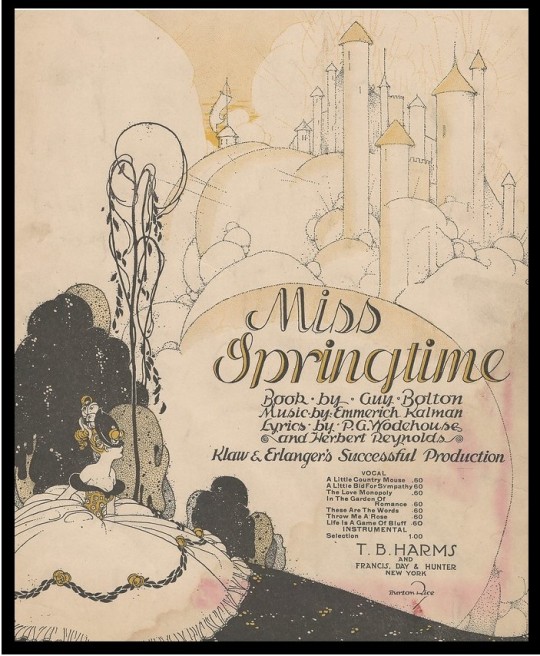
Miss Springtime (originally Little Miss Springtime) is a three act musical by Guy Bolton, with music by Emmerich Kalman and Jerome Kern, and lyrics by Herbert Reynolds and P.G. Wodehouse. It is based on the Hungarian operetta Zsuszi kisasszony by Miksa Brody and Ferenc Martos. It was originally produced by Klaw and Erlanger, staged by Herbert Gresham, and choreographed by Julian Mitchell.
The musical is best remembered for being the first time P.G. Wodehouse was credited for lyrics in a Broadway musical. In 1905 he went uncredited for the lyrics for “Put Me in My Little Cell” with music by Frederick Rosse, which was part of the score of Sergeant Brue.
The musical takes place in the Village of Pilota and in Budapest.
The story is woven around a grand opera star who goes back to his home village Incognito after sending word to the townspeople that he could not visit there. He then Impersonates himself at the request of promoters of a festival so that the townspeople might not be disappointed. He meets a young girl aspiring to the stage and encourages her. Later, it becomes known that he was an imposter and at the same time he discovers the girl loved a young man in her home town. He does not deny that he was an imposter and leaves, supposedly under arrest.
Reviewers praised the economy of setting, using only three sets, one for each act.
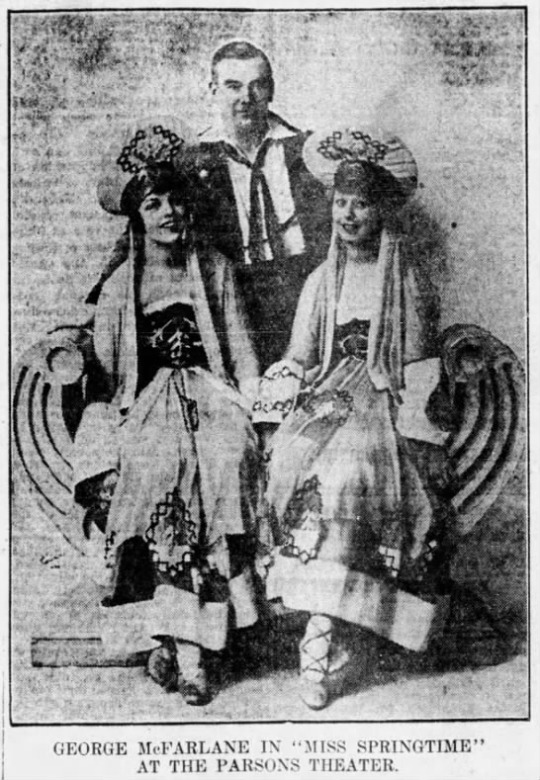
In its pre-Broadway tryouts, the musical was supposed to premiere at Nixon’s Apollo Theatre in Atlantic City on August 28, 1916, but the engagement was delayed, then canceled. Instead, it premiered at the Forest Theatre in Philadelphia.
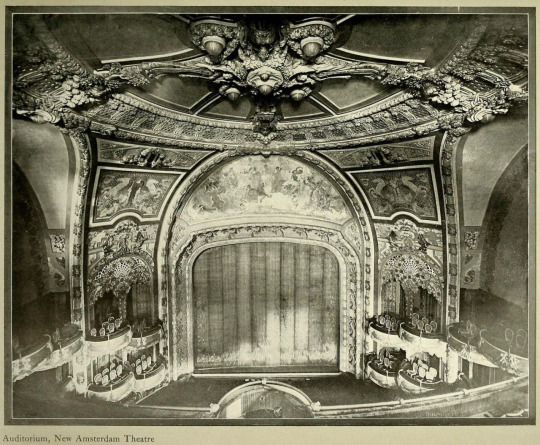
The musical opened on Broadway at the New Amsterdam Theatre (214 West 42nd Street) on September 25, 1916.
About the Venue: The New Amsterdam was built by Klaw and Erlanger in 1903. In 1913, Ziegfeld brought his "Follies" to the New Amsterdam. In 1937 it became a movie palace. In 1982, it earned landmark status and was purchased by the Nederlanders, who sold it to New York State in 1992. Disney performed extensive renovations before reopening the theatre in 1997 with The Lion King.
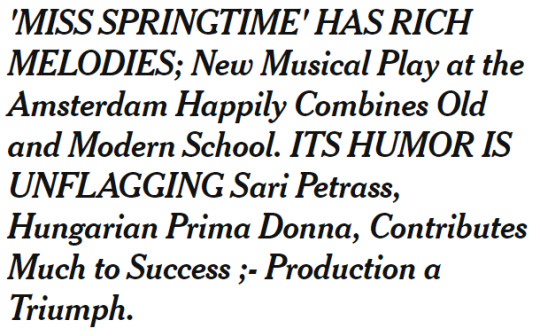
Reviews were positive, especially from the New York Times, which reviewed it twice - each time glowingly.
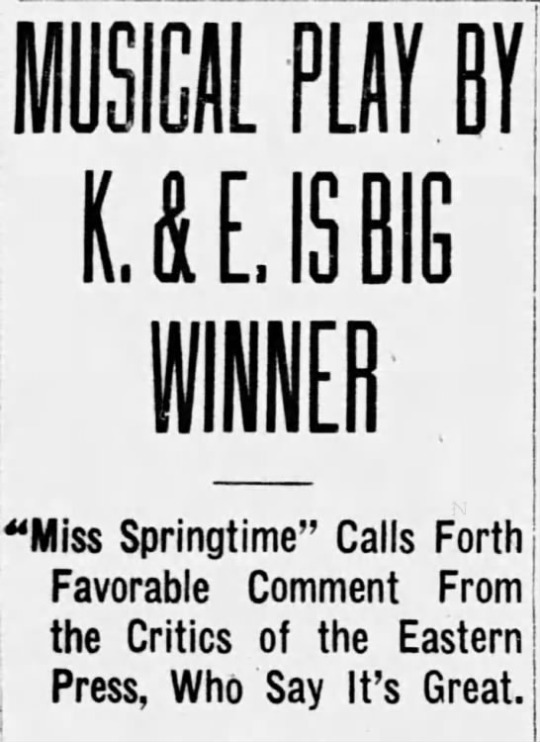
But all was not well between Kern and Wodehouse. In his personal correspondence, Wodehouse records an overseas rift between the two.

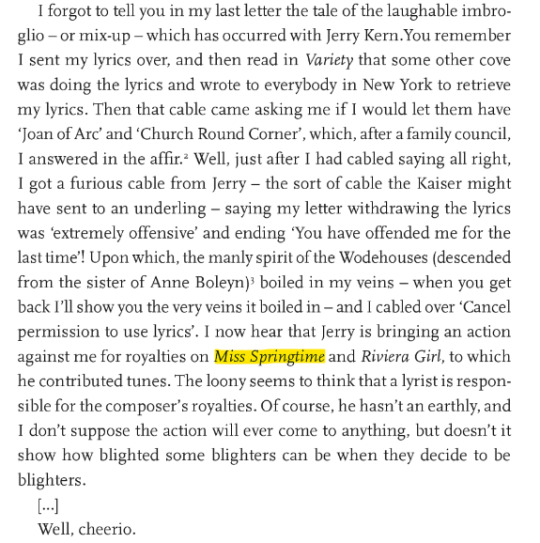
Writing in Vogue, Wodehouse further added to his thoughts about the musical:
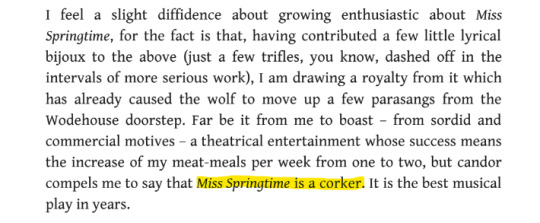
It closed on April 7, 1917 after 224 performances.

Miss Springtime finally played Atlantic City at the Apollo Theatre on February 15, 1918, as part of its post-Broadway tour. Several members of the original company were still part of the company of 80: John E. Hazzard, George MacFarland, and Charles Meakins.
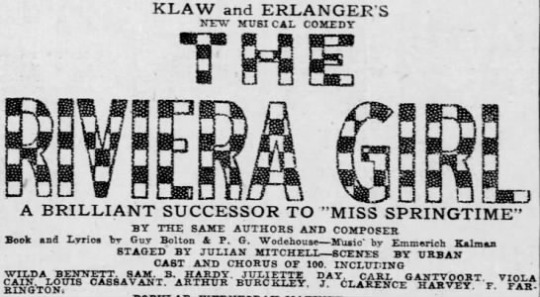
In September 1917, while Miss Springtime was still touring, Klaw and Erlanger rolled out a follow-up musical, The Riviera Girl, also by Kalman, Bolton and Wodehouse with a cast of 100 - up 20 from Miss Springtime. It also played at the New Amsterdam, accruing 78 performances.
Miss Springtime continued to tour until April 1919.
#Miss Springtime#broadway musical#Atlantic City#Nixon's Apollo Theatre#broadway#P.G. Wodehouse#Klaw & Erlanger#Emmerich Kalman#New Amsterdam Theatre#1918#Jerome Kern#Musical
16 notes
·
View notes
Text
POLLY WITH A PAST
1917

Polly With a Past is a three act play by George Middleton and Guy Bolton. It was originally produced by David Belasco and directed by Louis Massen. The play starred Ina Claire.
The play takes place in an apartment in New York City in late July and a summer home in North Hampton, Long Island in early August. It depicts the efforts of two young men to help a shy friend, Rex, win the attention of the aloof woman he loves; they arrange for their young housekeeper, Polly, to pose as a glamorous French rival for Rex's affections, but this leads to romantic complications.
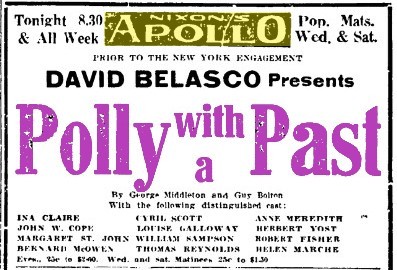
Polly with a Past premiered at Nixon’s Apollo Theatre on the Boardwalk in Atlantic City NJ on June 11, 1917.

Before moving on to Broadway, the play was seen at two more Jersey Shore theatres: The Savoy in Asbury Park, and the Broadway in Long Branch.

The play opened on Broadway on September 6, 1917 at the Belasco Theatre.

The Broadway cast was headed by Ina Claire as Polly, Herbert Yost as Rex (both pictured above), with Winifred Fraser, H. Reeves-Smith, Thomas Reynolds, and Cyril Scott. It ran for nearly a year.

The piece was presented in London in 1921 starring Edna Best and Donald Calthrop, with a supporting cast including Noël Coward, Edith Evans, Henry Kendall, Claude Rains and C. Aubrey Smith, running for three months.

It was adapted for film in 1920 in which Ina Claire reprised her role as Polly Shannon. Clifton Webb was also in the cast. The film is now considered lost.

The film played in Atlantic City at the Bijou Theatre, Boardwalk and South Carolina. Opening in 1903, this was the first movie house in Atlantic City. By 1920 it had been renamed the Cort Theatre. It was was demolished in 1924.

A musical version simply titled Polly played on Broadway in 1929. Archie Leach, who later became known as Cary Grant, was in an out-of-town tryout of the musical. Also in the cast were Fred Allen (in a newly-created part) and June Tripp in the title role. Leach was replaced as Rex by John Hundley for the Broadway run, which opened at the Lyric Theatre on January 8, 1929, and closed after just 15 performances.
#Polly With A Past#Ina Claire#Atlantic City#1917#Nixon's Apollo Theatre#David Belasco#Belasco Theatre#George Middleton#Guy Bolton#Broadway Play#Noel Coward#Edna Best#Polly
28 notes
·
View notes
Text
DAYBREAK
1917
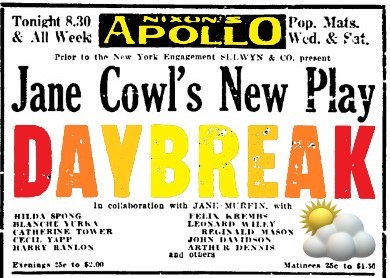
Daybreak is a play by Jane Cowl and Jane Murfin. It was originally produced by Selwyn and Company staged by Wilfred North and Miss Cowl.
Successful businessman Arthur Frome, who drinks too much, pushes a newsboy under an automobile, thus causing him severe injuries. His wife Edith then becomes disillusioned with her husband and leaves him. After an absence of a few years, Edith returns to her husband but offers no explanation of her behavior. Soon, however, Arthur becomes suspicious when she and their family friend, Dr. Brent, frequently visit a house in which a small child is living. Arthur has Edith followed by the wife of one of his employees, whom he has caught stealing, and soon discovers that the child, who is gravely ill, is his own. Edith confesses that she did not want to raise their child under the influence of a drunkard and so left him in someone else's care. Soon after this confession, Arthur is shot by the husband of the woman who has followed Edith because the man suspected his wife of having an affair. Arthur recovers, however, as does the child, and through Dr. Brent's intervention is happily reconciled with Edith, with whom he plans a new life.
About the Title: The play begins at daybreak in a darkened hallway of a New York apartment. Cowl and Murfin were intent on creating the mood of daybreak without resorting to clichés that might result in laughter. They nixed a visit from the milkman and a crowing rooster. They settled on a single shaft of yellow light piercing the darkness of the quiet room. The first scene is played in silence with no dialogue to create the ‘hush’ of early morning.
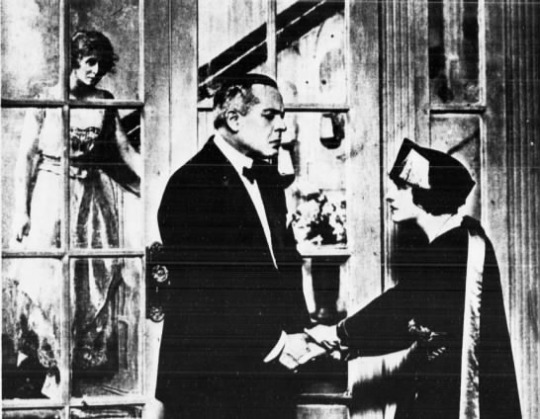
Daybreak premiered in Atlantic City at Nixon’s Apollo Theatre on the Boardwalk on June 18, 1917.
“[The play] was presented to early summer reporters at Atlantic City. It will not, therefore, be an unusual sight in Atlantic City to see a large number of people going home after ‘Daybreak'.” ~ WASHINGTON POST
Edith Frome was played by Blanche Yurka, a performer that Cowl had worked with and promised to help in her career. She was later cast in another play by Cowl and Murfin. Arthur Frome was played by Frederick Truesdell, one of Broadway’s most popular leading men.
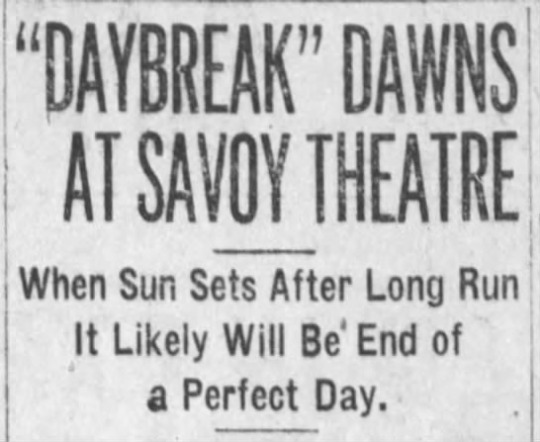
In late July and early August, the play was seen on the Jersey shore in Asbury Park at The Savoy and Long Branch at the Broadway.
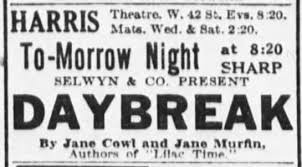
Daybreak opened on Broadway at the Harris Theatre (254 West 42nd Street) on August 14, 1917.
About the Venue: The Harris (named after William B. Harris) was built in 1904 as the Lew Fields Theatre. It was variously known as the Hackett, Wallacks, the Frazee, and finally the Anco Cinema. In 1988, the interior was gutted and it was used as retail space. It was finally demolished in 1997 as part of the 42nd Street redevelopment.

This was the second collaboration between Cowl (above) and Murfin, who previously penned Lilac Time earlier in 1917. Cowl also performed in Lilac Time, which closed on June 9th at The Harris (having transferred from The Republic), allowing Daybreak to move in. Between the two plays, Lilac Time proved the more popular and more successful. In October 1918 they collaborated on a third production, Information Please, with Cowl again performing, which was less successful still. In December 1919, the pair had their most successful script, Smilin’ Through, although they wrote it under the pseudonym Allan Langdon Martin. It inspired two films and two television adaptations. In 1932, Smilin’ Through was the basis for a flop musical titled Through The Years by Vincent Youmans.
"I am really pretty tired," she said. "You see, last summer was a strenuous one. I live at Great Neck on Long Island, and my movie work was done at Fort Lee NJ. I used to get up every morning at 5:30 am and shortly after after 6:30 I was in my car and on my way to Fort Lee. At 7 I was in my dressing room, by 8 I was in the studio. Then it was work until 5 or 6, with a short time off for lunch. Back to New York and rehearsals for "Daybreak,” my new play, until all hours. ~ JANE COWL, OCTOBER 7, 1917
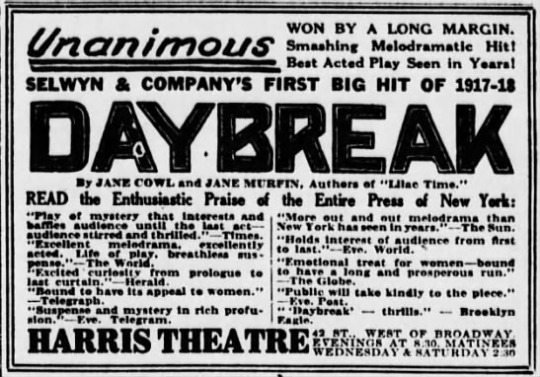
After the play was established on Broadway, Jane Cowl joined the road company of her Lilac Time. As of October 1917, Cowl was also seen on cinema screens in The Spreading Dawn (a title oddly similar to Daybreak), a civil war drama.
Daybreak closed on Broadway on October 13, 1917 after 71 performances.

Daybreak was filmed in 1918 starring Emily Stevens and Julian L’Estrange. It is now considered a lost film.
#Daybreak#Jane Cowl#1917#Jane Murfin#Selwyn & Co#Nixon's Apollo Theatre#Broadway#Broadway Play#Harris Theatre
18 notes
·
View notes
Text
SEVENTH HEAVEN
1922

Seventh Heaven or 7th Heaven is a play in three acts by Austin Strong. It was originally produced and directed by John Golden. The leads were played by George Gaul as Chico and Helen Menken as Diane. Also in the cast of the play was Frank Morgan as Brissac.
Strong originally conceived of the play as a one-act in 1918. It was then titled simply “Heaven”. In May 1920 it was given its first performances by Jessie Bonstelle's Detroit stock company, which featured Katherine Cornell.
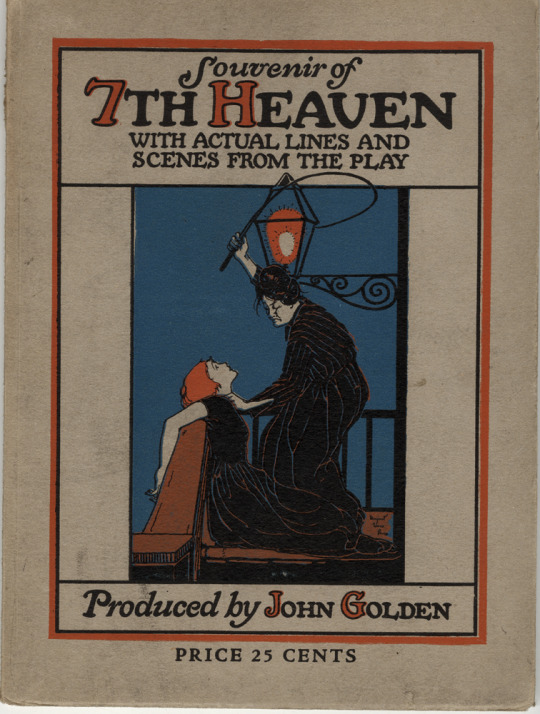
ACT I ~ A street in Paris.
ACT II ~ "Heaven." Three days later.
ACT III ~ Four years later.
A romance between Chico, a street cleaner and Diane, a young prostitute, blooms under the shadow of World War I.

The play made its premiere at the Lyceum in Elmira NY on May 11, 1922. Elmira was not a usual city for a premiere, and there were doubts whether the Lyceum could handle Broadway-scale scenery.

After the first performance, Golden reported that changes to the script were already being made.
“This evening author Strong is going to spend bis time in the gallery of the theater. He wants to get the opinion of the college girls and others who inhabit that portion of the playhouse.” ~ ELMIRA STAR-GAZETTE, MAY 13, 1922

The play moved from Elmira to Nixon’s Apollo Theatre on the Boardwalk in Atlantic City NJ on May 15, 1922. After Atlantic City, the play was variously re-titled as Three Candles, and Valor, before coming back to 7th Heaven. The play took the summer off.

Seventh Heaven ran on Broadway at the Booth Theatre from October 30, 1922, to July 1924 for a total of 704 performances. It became the 5th longest running non-musical play in Broadway history.

On December 3rd, just five weeks into the play’s run, tragedy struck when company member Fred Holloway (who played ‘the Rat’), unexpectedly died. The play was his long-awaited Broadway debut.

Two films were based on the play. On November 18, 1927, a silent film starring Janet Gaynor opened at the Stanley Theatre (later known as the Roxy) on the Boardwalk and Kentucky Avenue in Atlantic City.

The 1937 sound version opened at the Casino Theatre on Steel Pier in Atlantic City on March 26th. It starred Simone Simon and James Stewart. The film earned 5 Oscar nominations, winning in 3 categories.
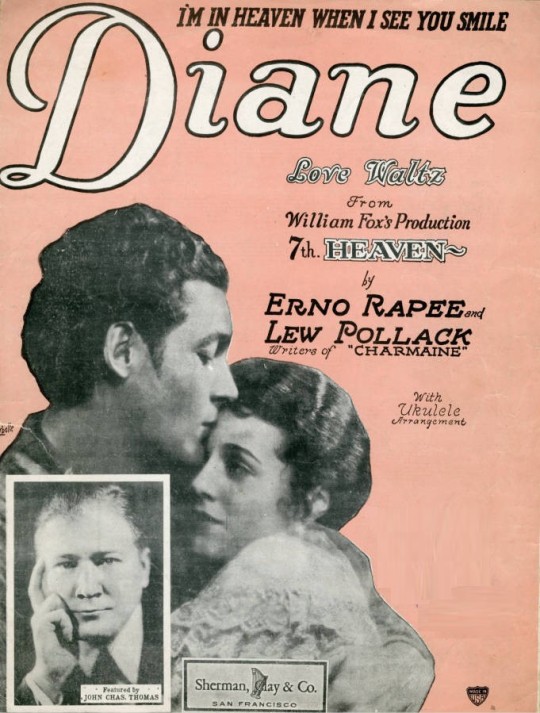
The song “Diane” was written specifically for the film version.

In 1955, the play was the basis for a musical of the same title by Victor Young and Stella Unger. It was produced on Broadway at the ANTA Playhouse (now the August Wilson Theatre) on May 26th starring Gloria DeHaven, Kurt Kasznar, Robert Clary, Beatrice Arthur, and Ricardo Montalban. When the show ran into trouble, Jerome Robbins was brough in as ‘show doctor’. It ran just 44 performances.
#Seventh Heaven#7th Heaven#Austin Strong#Helen Menken#John Golden#1922#Nixon's Apollo Theatre#Atlantic City#Booth Theatre#Broadway Play#Broadway Theatre#Frank Morgan
7 notes
·
View notes
Text
SEE SAW
1919 - 1920

See-Saw is a musical in two acts by Louis A. Hirsch (music), book and lyrics by Earl Derr Biggers. It was originally produced by Henry W. Savage, directed by John McKee with musical staging by Julian Alfred.
The musical is based on the novel and un-produced non-musical play Love Insurance by Earl Derr Biggers.
Cynthia Meyrick, daughter of Spencer Meyrick. a wealthy Detroit auto manufacturer, has promised to marry Lord Harrowby, a rattle-brain spendthrift. Although he owns a yacht, Harrow has debts and his creditors show no mercy. Harrowby induces Lloyds to insure him against the loss of Cynthia. Lloyds American agent, Richard Minot, assures the home office that be will never leave Lord Harrowby until he is married to Cynthia. Minot has no idea that Cynthia is the girl he met and fell in love with in France without learning her name. The discovery comes when Harrowby's yacht, with wedding party and guests aboard, is setting sail. In Florida, there are more complications, including a demand by Cleo Ray, an actress with whom Lord Harrowby had an affair some years back.
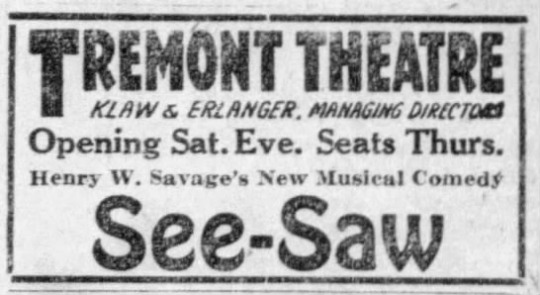
See-Saw had its world premiere in Boston MA at the Tremont Theatre on August 2, 1919. An actors’ strike threatened to prematurely close the show. Savage filed injunctions and threatened legal action against anyone striking.

See-Saw opened on Broadway on September 23, 1919 at the George M. Cohan Theatre (1482 Broadway at West 43rd Street). It was originally scheduled to open on the 22nd, but was delayed a day.
About the Venue: It was built in 1911 by George M. Cohan and Sam Harris. It was sold in 1915, but it was lost to the bank in a mortgage settlement in 1938, and was torn down
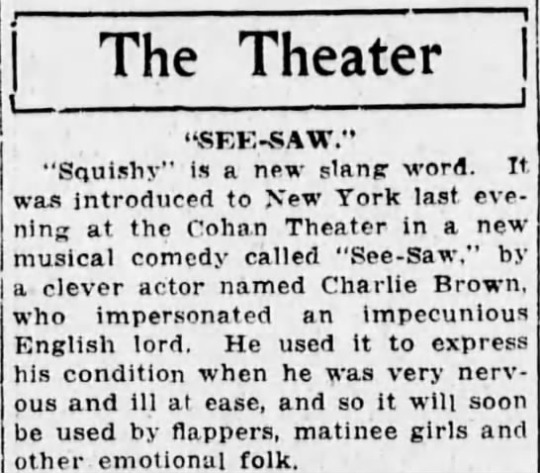
In addition to introducing the word ‘squishy’, the production was also praised for innovating the ‘student chorus’, one which used singers as understudies for the leading role, training them for future stardom.

Most critics praised Der Biggers book, but found the songs trite and familiar by comparison. Some critics carped about the multiple encores of the song “When Two Hearts Discover.” One newspaper (the World) numbered the repetitions as a dozen!

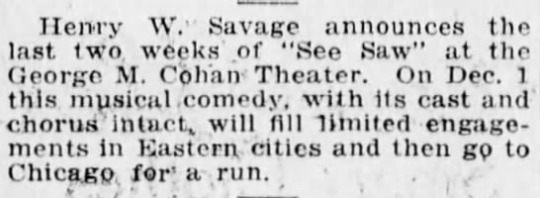
See-Saw closed on December 1, 1919 with 89 performances.
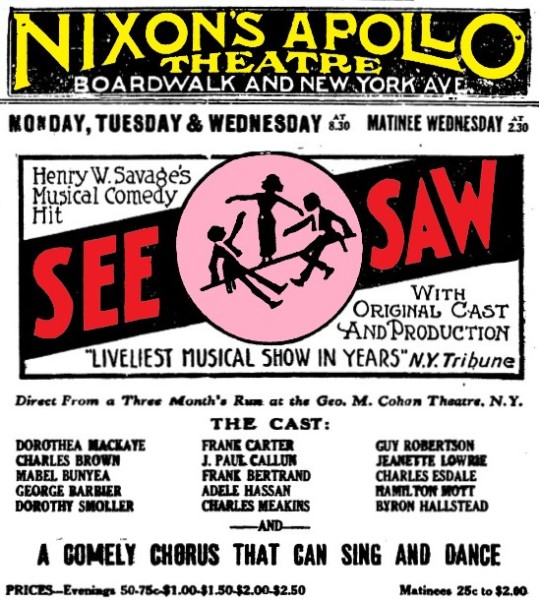
The musical opened in Atlantic City at Nixon’s Apollo Theatre on December 29, 1919.
#See-Saw#Henry W. Savage#musical#Broadway Musical#Atlantic City#Nixon's Apollo Theatre#George M. Cohan Theatre
4 notes
·
View notes
Text
HAVE A HEART
1916-1917
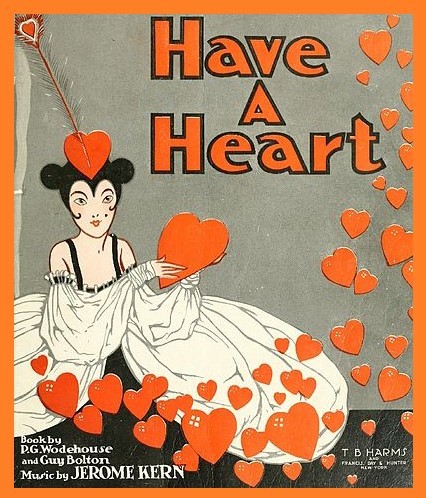
Have A Heart is a musical in two acts and three scenes by Jerome Kern with a book and lyrics by Guy Bolton and P.G. Wodehouse with additional music and lyrics by Schuyler Greene, James Kendis, Charles Bayha and Jerome Kern. It was originally produced by Henry W. Savage and staged by Edward Royce.
Although it did not play the Princess Theatre, it was one of five musicals known as ‘the Princess Musicals.’ At the opening night of the Bolton / Kern collaboration, Very Good Eddie, Kern introduced Bolton to his former collaborator Wodehouse. By the end of the evening, the three had agreed to work together. Their first full collaboration was Have a Heart.
The musical takes place in (fictional) Blueport, Rhode Island in the present (1917). Act I: Lingerie Room at Schoonmaker’s Department Store; Act II: Lounge of the Ocean View Hotel.
Estranged couple Ruddy and Peggy Schoonmaker still love each other, but he is involved with predatory Dolly Barbizon and she is being wooed by confidence man Captain Charles Owen, who is passing forged currency. On the eve of their divorce, Ruddy and Peggy run off together and hide out at the Ocean View Hotel in Rhode Island. Dolly, Owen, and others track them down, and through the quick thinking of the elevator boy Henry, the forger is exposed.
Rehearsals began during the first week in December 1916.
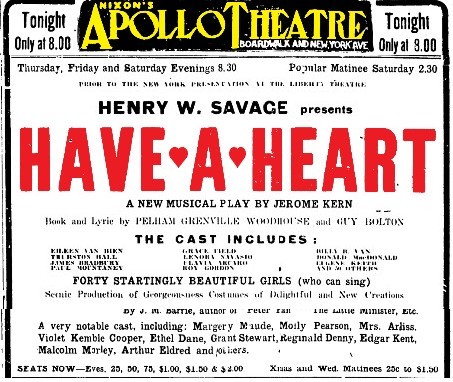
Have A Heart premiered in Atlantic City at Nixon’s Apollo Theatre on the Boardwalk on December 28, 1916. It featured 40 beautiful girls - who could sing!
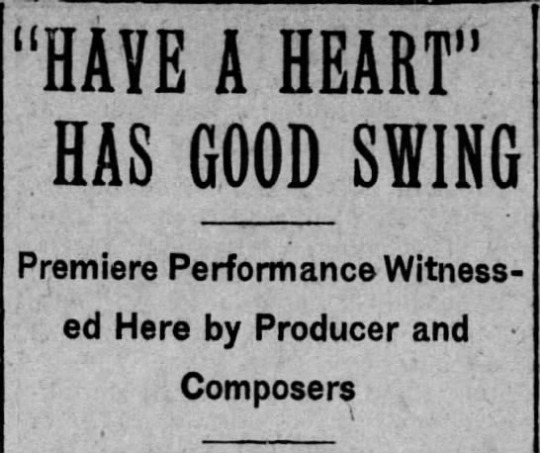
On New Year’s Day, the musical was at the Trent Theatre in Trenton NJ, followed by the Reading Academy of Music in PA (attended by Kern and Bolton), and a single night at the Playhouse in Wilmington DE.
The hit song was the second-act duet “You Said Something” for Ted and Lizzie. Kern himself preferred “And I Am All Alone,” sung by Ruddy and Peggy. The patter song “Napoleon” was recorded by its originator Billy B. Van.
“He was shorn off short,
But was one good sport
And I take after Nap!”

Have a Heart opened on Broadway at the Liberty Theatre (234 West 42nd Street) on January 11, 1917. It played 76 performances.
About the Venue: The Liberty was built in 1904 to present Rogers Brothers musicals. In 1933, it was made over as a movie theatre and continued this function into the 1980s. In 2000, Madame Tussaud's Wax Museum was built on the site. Although the building's exterior is still standing, the interior is no longer in use as a theatre.

"’Have a Heart' never will astound anybody by its originality, but it moves with a swing that is not unlikely to carry it to success in a season when lively musical comedy is in demand. Now and then there is a bright line, and the authors have shown considerable skill in distributing the dullness. Just when it begins to be oppressive someone says something about love being the greatest thing in the world and the orchestra leader gets up and conducts a musical number.” ~ NEW YORK TRIBUNE
“A vacuous and melancholy specimen.... I can discover nothing In the affair worthy of mention.” ~ GEORGE JEAN NATHAN
“Bolton has fallen down on hie dialogue as he usually does for he has a faculty for starting out toward a clever line and then making a miserable failure of It by poor construction.” ~ EMORY B. CALVERT

~ March 11, 1917
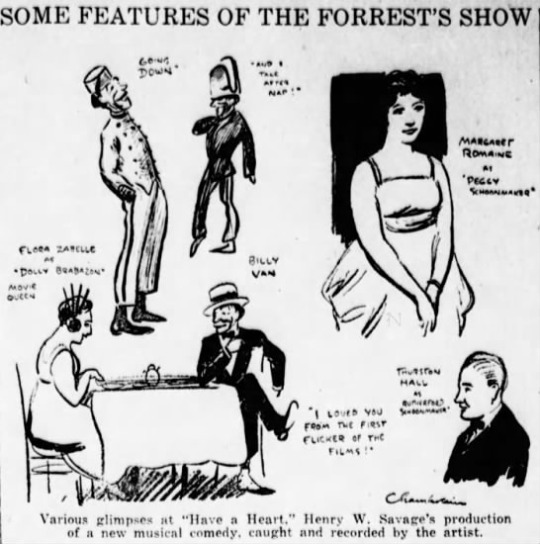
The show played its final performance on March 17, 1917 clocking 76 shows on Broadway. It immediately transferred to Philadelphia’s Forrest Theatre.
In the two years following its Broadway opening, with a Company A and a Company B touring simultaneously, it played in no fewer than 36 states and five Canadian provinces.

Have A Heart returned to Atlantic City at The New Nixon Theatre (later known as The Globe Theatre) on the Boardwalk on April 9, 1917.
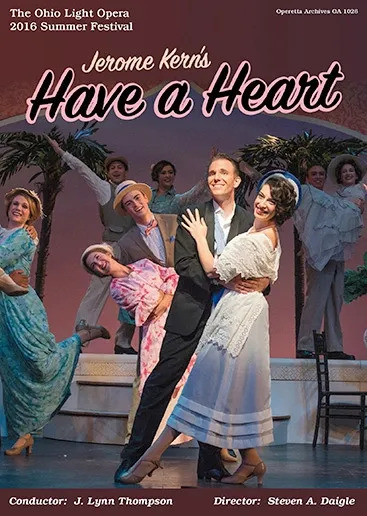
The Victor Light Opera recorded excerpts in 1930. The musical was revived in New York by Musicals Tonight in May 2004. In 2005, Comic Opera Guild released a complete cast recording. In 2016, it was produced by the Ohio Light Opera.
#Jerome Kern#Have A Heart#Broadway Musical#Musical Comedy#Princess Musicals#PG Wodehouse#Guy Bolton#Atlantic City#Nixon's Apollo Theatre#New Nixon's Theatre#Boardwalk#1917#Henry W. Savage#musical#Maria Dresser#Flora Zabelle#Billy B. Van
4 notes
·
View notes
Text
HE AND SHE / THE HERFORDS
1911-12 / 1917 / 1919-1920

He and She is a play in three acts by Rachel Crothers. Written in 1909, it was first produced in 1911, then again in 1912 under the title The Herfords, but did not appear on Broadway until late 1919 reverting to the title He and She.
‘He and She’ is about a husband and wife who are both trying to have careers as sculptors. They both submit work to a competition, and the wife wins over the the husband, which he does not take well. The wife ultimately decides to leave her work in order to take care of her teenage daughter who is having issues.
The play was given a reading in Carruthers hometown of Bloomington IL in the summer of 1911.
The first staging of the play premiered in Albany New York in mid-November 1911. From there, it moved to Poli’s Theatre in Meriden CT.
The play was scheduled to tour, with no Broadway aspirations, but by the end of the year, star Viola Allen was cast to take the role (She) originated by Emma Dunn. With Allen, the play now had the requisite prestige and an opening at Broadway’s Maxine Elliott’s Theatre was rumored imminent.
Just after the first of the year, the play was reported to be back in rehearsal at Daly’s Theatre in NYC produced by Liebler & Co.
By January 9th the play was headed to the Plymouth, not Maxine Elliott’s. This is when the title was changed to The Herfords, after the surnames of the he and she of the previous title.
By January 22nd, The Herfords had been diverted to Boston, opening on March 1, 1912. It then moved on to tour in other cities, as far afield as Oregon.
By the end of 1912, Crothers had moved onto to new plays: Young Wisdom, and Ourselves, both of which reached Broadway, placing He and She / The Herefords in cold storage. Broadway saw three more Crothers plays before He and She resurfaced in mid 1917.

On June 25, 1917, the "new” production premiered in Atlantic City at Nixon’s Apollo Theatre on the Boardwalk. It was produced by Harris and Cohen and starred Effie Shannon and Maclyn Arbuckle in the title roles. Several New York managers pronounced it “a fine success.” Cohan and Harris placed the play back in rehearsals with thoughts of an October Broadway opening. In early August Maclyn Arbuckle suddenly withdrew from the cast, taking an opportunity to perform with William Faversham in Shaw’s Misalliance.
Maclyn made a shrewd move because the Crothers play on Broadway in October was titled Mother Carey’s Chickens, not He and She. In November 1917 a new Crothers play premiered in Atlantic City titled Once Upon a Time. It, too, moved to Broadway and once again, He and She fell by the wayside.
In June 1919, the play resurfaced again - Crothers’ resume considerably bolstered. She now wished to act as well as write. Interestingly, the play had already been released for stock and amateur performances some time earlier.

At the start of the 1919-20 season the Shuberts announced their intention to produce He and She for Broadway, calling it a “new play.” In this production, Crothers herself took the role of Mrs. Herford (aka She), and Cyril Keightley played Mr. Herford (He), with film star Faire Binney in the mix. The role of Mrs. Herford was supposedly based on Carruthers’ mother. The play launched a pre-Broadway tryout tour in Baltimore in June 1919.
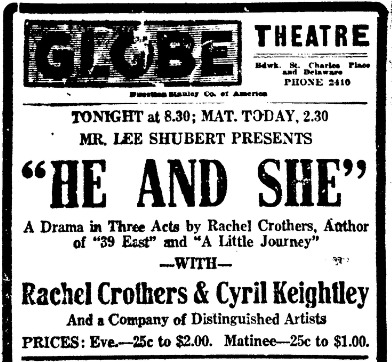
On its way to Broadway, the play stopped (again) in Atlantic City at the Globe Theatre on the Boardwalk on February 9, 1920. It moved immediately (24 hours later), to Broadway.

He and She (finally) opened on Broadway on February 12, 1920 at the Little Theatre (now the Hayes) 240 West 44th Street, Broadway’s smallest and most intimate venue
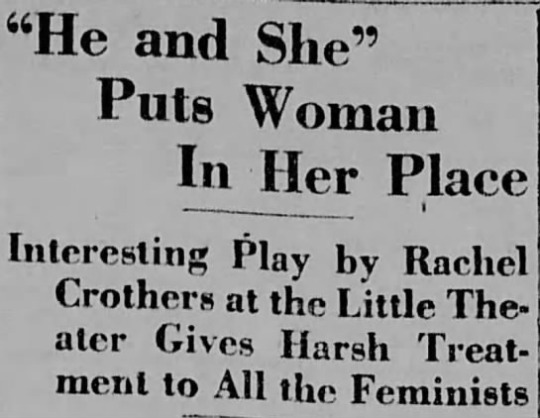
“Miss Crothers herself played pert of the artist's wife. Under strain of being author and leading lady too she was visibly nervous. In her quieter scenes she was excellent but when was called upon to played the tenser moments she played hard and hammered her lines with rather disturbing vehemence. Cyril Keightley gave an excellent performance, but the rest of the cast was not very good.” ~ HEYWOOD BRAUN
“The authoress acts well, although in the more exciting moments she is crude and overplays." ~ BROOKLYN TIMES UNION
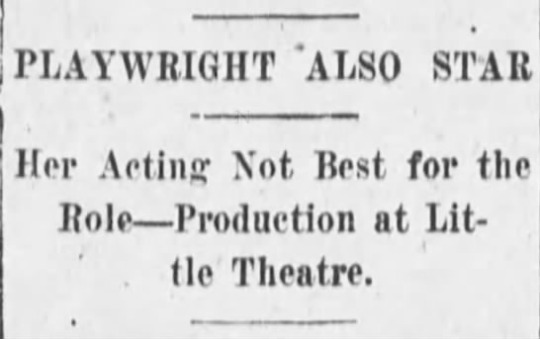
” The staleness of some of the sentiments might justify the rumor of the play's age, but It would not have been enlivening at any period.” ~ THE SUN & NEW YORK HERALD
“’He and She' seems peopled less with folks than with embodied points of view, and the play seems less a dramatic story than a symposium." ~ ALEXANDER WOOLCOT

On March 21, 1920, Crothers wrote a letter to the editor of The Tribune to take issue with the manipulation of an interview she gave with the newspaper. She claimed the author characterized her unfairly and manipulated her words about the New York critics.
He and She closed on Broadway after just 28 performances. Crothers continued to write and direct on Broadway until 1943, scoring more than a dozen more new plays but she never acted on Broadway again.
#He and She#Rachel Crothers#The Herfords#Broadway#Broadway Play#Atlantic City#Feminism#Stage#Globe Theatre#Nixon's Apollo Theatre#Little Theatre
2 notes
·
View notes
Text
AS HUSBANDS GO
1931

As Husbands Go is a three-act play by Rachel Crothers. It was originally produced by John Golden and staged by the author.
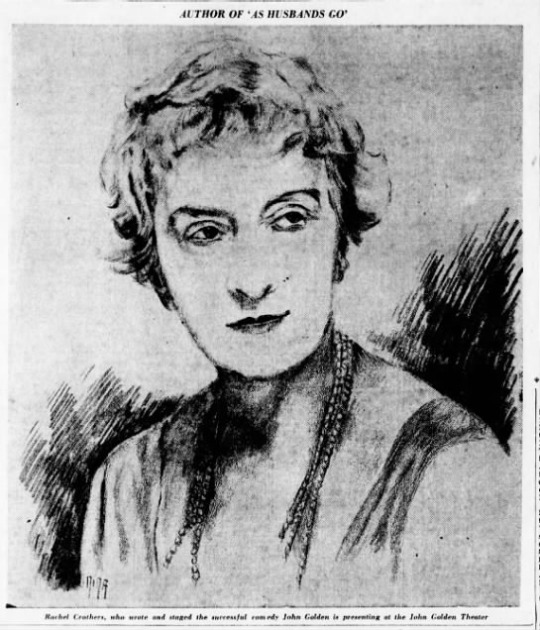
The play takes place at a café in Paris and the living-room in the Lingard House, ten miles from Dubuque, Iowa.
While in Paris, a widow from Iowa and her younger married neighbor, discover alluring gentlemen. The widow is attracted to an elderly boulevardier, while the neighbor is smitten with a handsome (and younger) English author. Instead of souvenirs, the ladies daringly bring the men back home to Iowa.
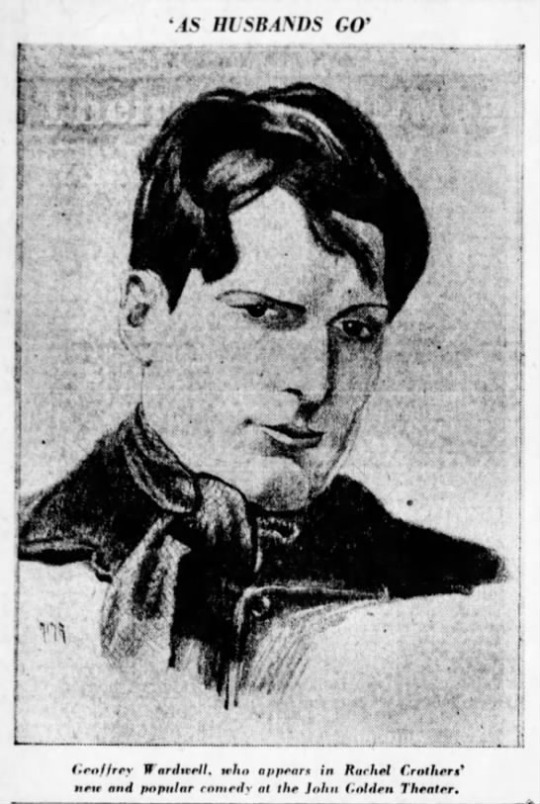
“If all husbands were as gallant as Charles Lingard in Rachel Crothers’ comedy... divorce courts could go out of business; that is, provided all wives were as delightfully tractable as pretty Lucile Lingard.” ~ BROOKLYN LIFE

For the world premiere, Golden chose Brandt’s Boulevard Theatre in Jackson Heights NY. It opened for a week’s stay on February 23, 1931.
The play premiered on Broadway at (fittingly) the John Golden Theatre on March 5, 1931. This was the first of three venues named for the producer. Located on 58th street, it stopped presenting live theatre in 1936 and was demolished in 1985. The third theatre named for Golden is now known as the Bernard Jacobs.

“If a smiling lady should be found dancing in the streets in Fifty-eighth Street, to be specific, with laurel and bay leaves in her hair, that would be Rachel Crothers. For the second time in three years she has taken advantage of John Golden's adventurous generosity and produced a hit in his name when he was no closer to it than Palm Beach, Florida. Ticket brokers, I'm told, are willing to buy all the seats the Golden office will sell for the next several weeks of ‘As Husband Go’, so sure are they that it is to be listed among the hits.”
Mantle is referring to the fact that Golden was seldom in Manhattan. In January 1931 he purchased the play from Havana, and was in Palm Beach when it finally opened.



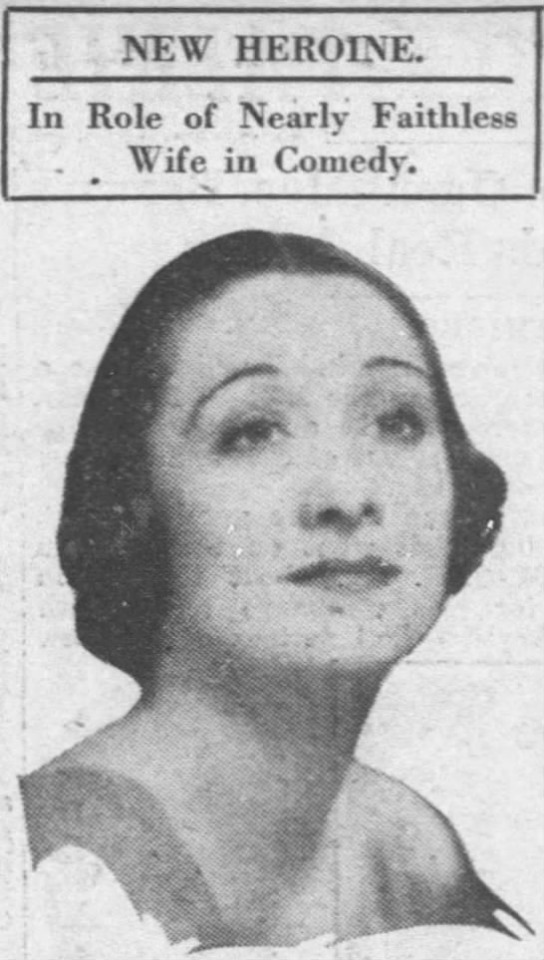
On May 4, 1931 Gloria Holden replaced Lily Cahill as Lucile Lingard. Cahill left the role suddenly for undisclosed reasons. Golden heard Holden on radio and signed her to make her Broadway debut.

The show’s 100th performance (a matinee on May 23rd) coincided with a military air show, so Golden moved the curtain time to 3:15pm to prevent audiences being distracted by the roar of aircraft motors.
At the same time in Los Angeles, producer E.E. Clive had presented a West Coast company of As Husbands Go. Clive would also produce the Broadway revival in 1933.

In late June 1931, Golden invested in some new-fangled technology - air cooling! Perhaps theatres would now be able to operate year-round? Cool!
After Independence Day, the play started to advertise “last weeks” and closed on July 11th. Golden had agreed to the play becoming one of the Theatre Guild’s subscription series. This was a consortium of cities nationwide that would share the same plays. One of those cities was Atlantic City.

Coincidentally, Clive’s California company wrapped up its run on September 12th, just as the Theatre Guild tour was preparing to launch. The production was integral in selling the play to Hollywood.

After a summer break, the play re-opened in Atlantic City at Nixon’s Apollo Theatre on the Boardwalk on September 28, 1931.
A new production, under the guidance of producers O.E. Wee and Jules J. Leventhal in mid-January. Again, Crothers provided direction. Wee and Leventhal were known as “W & L: The Revivers” with six productions in a short period of time - all revivals. Simultaneously, the play had been sold to stock and regional producers, virtually flooding the nation with Husbands!
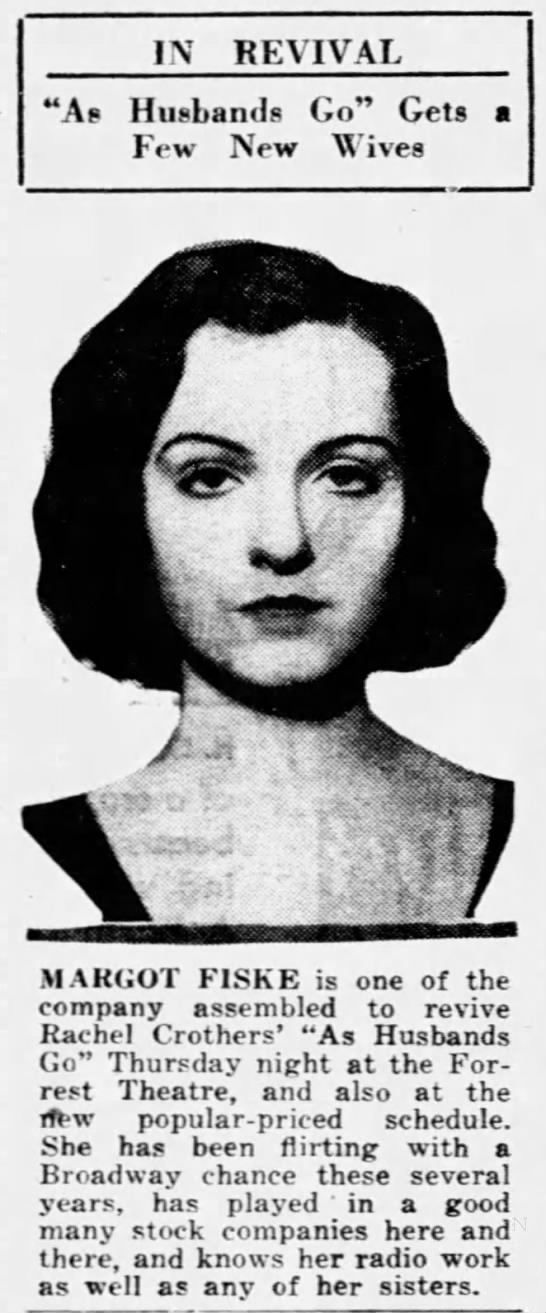
In January 1933, the play returned to Broadway at the Forrest Theatre, today known as the Eugene O’Neill. Remarkably, both the original Broadway production and the Broadway revival ran the same number of performances: 148.

In 1934, a film version was released. The screenplay was written by S.N. Behrman, Sonya Levien, and Fred Niblo Jr. and starred Warner Baxter as the titular Husband.

The film had its world premiere at the famous Steel Pier Theatre in Atlantic City on December 3, 1933, nearly two months before its general release in late January 1934.
#As Husbands Go#Rachel Crothers#1931#Broadway#Atlantic City#Broadway Play#Broadway Theatre#Nixon's Apollo Theatre#John Golden
4 notes
·
View notes